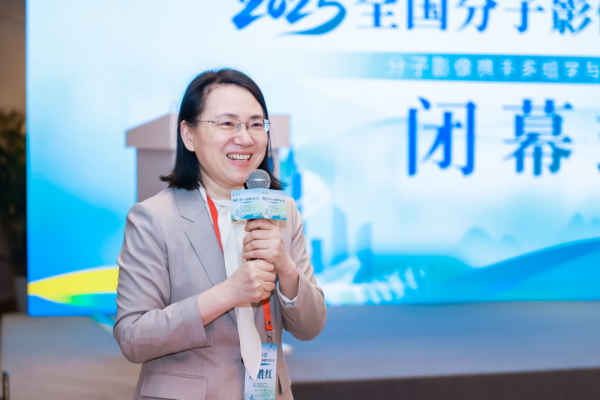Home> News
National Molecular Imaging Conference held in Nanjing
Updated: 2025-05-15
The 2025 National Molecular Imaging Conference was held in Nanjing, Jiangsu province, from April 11 to 13. Hosted by the Molecular Imaging Academic Subgroup of the Biophysical Society of China (BSC) and organized by Zhongda Hospital, Southeast University, the conference brought together leading minds to explore the convergence of molecular imaging, multi-omics and artificial intelligence.
The event featured 35 meticulously curated academic sessions and welcomed 108 prominent experts. Discussions spanned a wide range of topics, including molecular imaging and clinical translation, AI and big data analytics, radiomics, pathomics and multi-omics, as well as nano-materials and drug delivery systems, providing a panoramic view of cutting-edge scientific advances and offering new momentum for disciplinary development.

Participants of the 2025 National Molecular Imaging Conference pose for a group photo. [Photo/WeChat account: BSC]
Gu Ning from Nanjing University and Wang Fan, president of the BSC’s Molecular Imaging Academic Subgroup, delivered opening addresses. Gu emphasized the critical role of molecular imaging in precision medicine, advocating for cross-disciplinary integration, clinical translation and the nurturing of young talents.
Keynote speeches were given by distinguished experts including Zheng Hairong, professor at Nanjing University; Tian Jie, researcher at the Institute of Automation, Chinese Academy of Sciences (CAS); Mao Ying, professor at Huashan Hospital, Fudan University; Zhou Xin, researcher at the Innovation Academy for Precision Measurement Science and Technology, CAS; and Tian Mei, professor at Fudan University.
Their presentations covered diverse topics such as AI in biomedicine, molecular imaging and AI-based intraoperative molecular functional visualization and quantification, molecular subtyping and visualization of gliomas, human multinuclear MRI and applications of AI, as well as the inheritance and innovation of nuclear medicine molecular imaging.
The conference fostered in-depth academic exchange, with rich dialogues taking place in both plenary and parallel sessions. These discussions mapped out the future directions for molecular imaging technologies and highlighted the potential of multidisciplinary innovation.

Ju Shenghong, vice-president of Zhongda Hospital, Southeast University, delivers a concluding address. [Photo/WeChat account: BSC]
At the closing ceremony, Ju Shenghong, vice-president of Zhongda Hospital, Southeast University, delivered a concluding address summarizing the conference’s highlights and achievements. She praised the fruitful outcomes and vibrant discussions that made the event a resounding success.
The 2025 National Molecular Imaging Conference not only built a high-level, diversified platform for academic exchange but also catalyzed breakthroughs in key molecular imaging technologies. The event further promoted the translation of scientific discoveries into clinical applications. Looking ahead, the addition of dedicated sessions for industry-academia-research collaboration could accelerate the commercialization of molecular imaging technologies in areas such as precision medicine and novel drug development, providing robust technical support for the Healthy China 2030 initiative.
